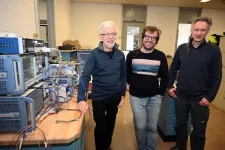(Press-News.org) Boulder, Colo., USA: GSA’s dynamic online journal, Geosphere, posts articles online regularly. Topics this month include an analysis of geoscience job applications; Uturuncu volcano, Bolivia; Picture Gorge Basalt; and the Red Bluff Granite Suite. You can find these articles at https://geosphere.geoscienceworld.org/content/early/recent .
Critical workforce skills for bachelor-level geoscientists: An analysis of geoscience job advertisements
G.W. Shafer; K. Viskupic; A.E. Egger
Understanding the skills bachelor-level geoscientists need to enter the workforce is critical to their success. The goal of this study was to identify the workforce skills that are most requested from a broad range of geoscience employers. We collected 3668 job advertisements for bachelor-level geoscientists and used a case-insensitive, code-matching function in Matlab to determine the skills geoscience employers seek. Written communication (67%), field skills (63%), planning (53%), and driving (51%) were most frequently requested. Field skills and data collection were frequently found together in the ads. Written communication skills were common regardless of occupation. Quantitative skills were requested less frequently (23%) but were usually mentioned several times in the ads that did request them, signaling their importance for certain jobs. Some geoscience-specific skills were rarely found, such as temporal understanding (5%) and systems thinking (0%). We also subdivided field skills into individual tasks and ranked them by employer demand. Site assessments and evaluations, unspecified field tasks, and monitoring were the most frequently requested field skills. This study presents the geoscience community with a picture of the skills sought by employers of bachelor-level geoscientists and provides departments and programs with data they can use to assess their curricula for workforce preparation.
Picture Gorge Basalt: Internal stratigraphy, eruptive patterns, and its importance for understanding Columbia River Basalt Group magmatism
Emily B. Cahoon; Martin J. Streck; Anthony A.P. Koppers
The Picture Gorge Basalt (PGB) of the Columbia River Basalt Group (CRBG) has been previously thought to be limited in its eruptive volume (<3000 km3) and thought to not extend far from its type locality. At present, PGB represents only 1.1 vol% of the CRBG with a relatively limited spatial distribution of ~10,000 km2. New age data illustrate that the PGB is the earliest and longest eruptive unit compared to other main-phase CRBG formations and that some dated basaltic flows reach far (~100 km) beyond the previously mapped extent. This study focuses on extensive outcrops of basaltic lavas and dikes south of the type locality at Picture Gorge, in order to reassess the spatial distribution and eruptive volume of the PGB. Field observations coupled with geochemical data indicate that PGB lava flows and mafic dikes covered a significantly greater area than shown on the published geologic maps. We find that additional mafic dikes located farther south of the original mapped distribution have geochemical compositions and northwest-trending orientations comparable to the dikes of the Monument dike swarm. We also identify new lava flows that can be correlated where stratigraphic control is well defined toward the original mapped PGB distribution. Our analyses and correlations are facilitated by comparison of 20 major- and trace-element abundances via a principal component analysis. This statistical comparison provides a new detailed distribution of PGB with stratigraphic significance that more than doubles the total distribution of PGB lavas and dikes and brings the eruptive volume to a new minimum of at least ~4200 km3. Geochemically correlated basaltic lavas and dikes in the extended distribution of PGB represent the earlier and later sections of the internal PGB stratigraphy. This is an intriguing observation as new geochronological data suggest an eruptive hiatus of ~400 k.y. during PGB volcanic activity, which occurred from 17.23 Ma to 15.76 Ma. The geochemical identifiers used to differentiate PGB from other main-phase CRBG formations include lower TiO2 (<2 wt%) concentrations, lower incompatible trace-element (i.e., La, Th, and Y) abundances, and a more pronounced enrichment in large-ion-lithophile elements (LILEs) on a primitive mantle–normalized trace-element diagram (Sun and McDonough, 1989). Geochemical characteristics of PGB are interpreted to represent a magmatic source component distinct from the other main-phase CRBG units, possibly a localized backarc-sourced mantle melt. However, this source cannot be spatially restricted as there are observed PGB lava flows and dikes extending as far east as Lake Owyhee and as far south as Hart Mountain, covering at least 15,000 km2. In context with the existing stratigraphy and the new extent of PGB lavas and dikes, these ages and coupled geochemical signatures demonstrate this mantle component was not spatially localized but rather tapped across a wide region.
Multiple spatial and temporal scales of deformation from geodetic monitoring point to active transcrustal magma system at Uturuncu volcano, Bolivia
Elizabeth Eiden; Patricia MacQueen; Scott Henderson; Matthew Pritchard
Uturuncu volcano in southern Bolivia last erupted around 250 ka but is exhibiting signs of recent activity, including over 50 yr of surface uplift, elevated seismic activity, and fumarolic activity. We studied the spatial and temporal scales of surface deformation from 1992 to 2021 to better understand subsurface activity. We tracked Uturuncu’s recent deformation using interferometric synthetic aperture radar (InSAR) data and the global navigation satellite system (GNSS) station UTUR, located near Uturuncu’s summit. We observed a spatially coherent signal of uplift from 2014 to 2021 from Sentinel-1 A/B satellites that indicates the Altiplano-Puna magma body, located 19–24 km below ground level, and previously noted as the source of the large region of deformation, is still active. The ground is now uplifting at a rate of ~3 mm/yr compared to prior rates of ~10 mm/yr. We corroborated this waning uplift with in situ data from station UTUR. We combined the Sentinel-1 data with TerraSAR-X interferograms to constrain an ~25 km2 region of subsidence located 11 km SSW of Uturuncu, with a source depth of 2.1 km below ground level to an active period of ~2.5 yr with ~5 mm/yr subsidence. We developed a conceptual model that relates these varying depths and time scales of activity in a transcrustal magmatic system. We associate the surface uplift with pressurization from ascending gases and brines from magmatic reservoirs in the midcrust. We infer the existence of brine lenses in the shallow hydrothermal system based on low subsurface resistivity correlated with surface subsidence.
Tectonomagmatic evolution of southwestern Laurentia: Insights from zircon U-Pb geochronology and hafnium isotopic composition of the Red Bluff Granite Suite, west Texas, USA
Munazzam Ali Mahar; Philip C. Goodell; Jason W. Ricketts; Eric J. Kappus; James L. Crowley ...
We provide laser ablation–multicollector–inductively coupled plasma–mass spectrometry (LA-MC-ICP-MS) and high-precision chemical abrasion–isotope dilution–thermal ionization mass spectrometry (CA-ID-TIMS) U-Pb ages and Hf isotopic compositions of zircons from the Red Bluff Granite Suite and mafic dikes in the Franklin Mountains of El Paso, Texas, USA. Granitoids exposed in the Franklin Mountains were previously divided into five magmatic stages based on cross-cutting relationships. Major and trace element compositions showed that these granitoids are ferroan, alkaline, and A2 type. Homogeneity in the whole-rock geochemistry suggests that the granite stages are genetically related and share similar petrogenetic histories. Weighted mean zircon 206Pb/238U dates from the older magmatic stage 1 alkali-feldspar quartz syenite and stage 2 alkali-feldspar granite are 1112.36 ± 0.35 and 1112.46 ± 0.37 Ma, respectively. The weighted mean εHf(t) values varying from +5.3 to +7.2 are similar to those of other regional ca. 1.1 Ga magmatic rocks throughout south- western Laurentia. Geochemical characteristics, petrological modeling, and enriched Hf isotopic composition suggest fractional crystallization of a basaltic magma that was produced by melting of an enriched mantle reservoir. However, zircon inheritance ages of ca. 1.3 Ga and 1.26–1.15 Ga are consistent with a minor contribution from felsic crustal basement. Our data and regional geology are consistent with a post-collisional slab break-off that facilitated asthenospheric upwelling and partial melting of the enriched mantle, possibly subcontinental lithospheric mantle, extending from Llano Uplift, Texas, in the southeast to California to the northwest. Magma thus generated upon differentiation produced ferroan and A-type granitoids.
GEOSPHERE articles are available at https://geosphere.geoscienceworld.org/content/early/recent . Representatives of the media may obtain complimentary copies of GEOSPHERE articles by contacting Kea Giles at the address above. Please discuss articles of interest with the authors before publishing stories on their work, and please refer to GEOSPHERE in articles published. Non-media requests for articles may be directed to GSA Sales and Service, gsaservice@geosociety.org.
https://www.geosociety.org
# # #
END
New articles for Geosphere posted early online
2023-03-08
ELSE PRESS RELEASES FROM THIS DATE:
Human Brain Project: spin-off receives EIC grant to develop energy-efficient AI technology
2023-03-08
The European Innovation Council (EIC) has recently announced that it will award a Transition grant to SpiNNcloud Systems GmbH, a deep-tech startup based in Saxony, Germany.
The team from SpiNNcloud Systems GmbH, a spin-off from Professor Christian Mayr’s research group at Technische Universität Dresden, is receiving a grant of 2.5 million euros for their groundbreaking project, “SpiNNode: SpiNNaker2 on the edge.”
“SpiNNaker2 is a bio-inspired supercomputer which was developed at my Chair in collaboration with Prof. Steve Furber’s research group at the University of Manchester as part ...
New GSA Bulletin articles published online ahead of print
2023-03-08
Boulder, Colo., USA: The Geological Society of America regularly publishes articles online ahead of print. GSA Bulletin topics studied this month include the nature and dynamics of China and Tibet; the Lower Mississippi Valley, USA; and the polarity of Mesozoic arcs along the western margin of North America. You can find these articles at https://bulletin.geoscienceworld.org/content/early/recent .
Magmatic-hydrothermal evolution of long-lived Nb-Ta-(Sn) mineralization in Lianyunshan, NE Hunan, South China
Nuerkanati Madayipu; Huan Li; Safiyanu Muhammad Elatikpo; Michael W. Förster; Hou-Xiang Zhou ...
The ...
Group exercise program for older adults led to more independent exercise despite pandemic restrictions, MU study finds
2023-03-08
COLUMBIA, Mo. -- Sticking with an exercise program can be tough, even during the best of times. But what about during a pandemic?
A new study by the University of Missouri and Oklahoma State University found that even when gyms were closed and there were other COVID-19 restrictions limiting face-to-face meetings, older adults who completed the Stay Strong, Stay Healthy exercise program — created at MU in 2005 — continued to maintain long-term exercise habits independently, which resulted in improved lifestyle changes and an increase in both physical energy and self-confidence.
“We ...
Incident atrial fibrillation appears to heighten dementia risk
2023-03-08
People with a recent diagnosis of atrial fibrillation (AF), the most common irregular heart rhythm, have a modestly higher risk of developing dementia than people without the condition, according to research published today.
“Previous studies that have examined the link between atrial fibrillation and dementia have yielded conflicting results, and we hope that our study’s large sample size helps to establish confidence in our findings,” said Dr. Nisha Bansal, a professor of medicine at the University of Washington School of Medicine. “The study also included a community based, diverse population, which may increase the generalizability ...
Lunar telescope will search for ancient radio waves
2023-03-08
UPTON, NY—Scientists at the U.S. Department of Energy’s (DOE) Brookhaven National Laboratory are leading a new effort to land a radio telescope on the moon. If successful, the project will mark the first step towards exploring the Dark Ages of the universe.
The Dark Ages are an early era of cosmological history starting about 380,000 years after the Big Bang. There were no stars or planets in the Dark Ages. It’s a point in time that scientists have never been able to observe. Though radio waves from the Dark Ages still linger in space, the abundance of radio interference on Earth has masked these signals from scientists seeking to study them.
If ...
How a metabolite causes inflammation and disease
2023-03-08
A new study shows for the first time a connection between a mitochondrial metabolite and the activation of an inflammatory response. Mitochondria are functional units of our cells that fulfil important tasks, i.e. chemical reactions, for the functioning of the cell. One of these tasks is the production of energy that is necessary for cell growth and reproduction. If certain chemical reactions in the mitochondrion change, diseases occur. For example, deficiencies in fumarate hydratase (FH) in the Krebs cycle, one of the most important metabolic pathways in mitochondria, ...
'Other' race/ethnicity linked to higher suicide and overdose risk in military members with mild TBI
2023-03-08
March 8, 2023 – Previous studies have reported high rates of death by suicide and drug overdose – including opioid overdose – in military service members with a history of mild traumatic brain injury (mTBI). A new study finds that those risks are highest among military members with mTBI who identify their racial/ethnic status as "Other," as opposed to standard racial/ethnic categories, reports the March/April issue of the Journal of Head Trauma Rehabilitation (JHTR). The official journal of the Brain Injury Association of America, JHTR is ...
Cancer Grand Challenges announces global research funding opportunity with nine new challenges
2023-03-08
The National Cancer Institute (NCI), part of the National Institutes of Health, and Cancer Research UK have announced nine new research challenges aimed at tackling some of the most profound problems in cancer research. The global funding opportunity is part of the Cancer Grand Challenges program, an initiative launched by NCI and Cancer Research UK in 2020.
The research initiative aims to inspire bold new ideas that have the greatest potential for advancing cancer research and improving outcomes for people affected by cancer. The new round of challenges, announced March 8, 2023, during the Cancer Grand Challenges Annual Scientific Summit in London, is open until June ...
Genes in beans! Bean genome sequenced for improved nutrition
2023-03-08
The faba bean genome, which at 13 billion bases is more than four times the size of the human genome, has been sequenced for the first time and is published today (08 March 2023), in Nature. This is an extraordinary technical achievement and crucial to efforts to breed beans with optimum nutritional content and sustainability of production.
A consortium of scientists from Europe and Australia, led by the University of Reading (UK), Aarhus University (Denmark) and the University of Helsinki (Finland), worked together on this large scale sequencing project.
The project to fully decode the genome went on to test out its usefulness by searching for genes involved ...
MD Anderson research highlights for March 8, 2023
2023-03-08
HOUSTON ― The University of Texas MD Anderson Cancer Center’s Research Highlights showcases the latest breakthroughs in cancer care, research and prevention. These advances are made possible through seamless collaboration between MD Anderson’s world-leading clinicians and scientists, bringing discoveries from the lab to the clinic and back.
Recent developments include overlooked proteins from long noncoding RNAs that likely play a functional role in breast cancer, inhibiting tumor-associated neuronal cells to improve treatment response in pancreatic cancer, ...


